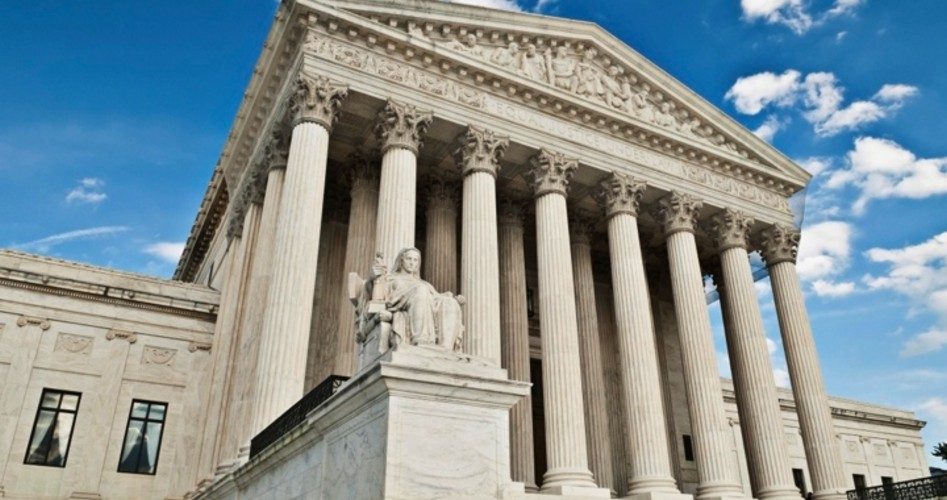
The Supreme Court on Monday will hear challenges to the Environmental Protection Agency’s application of limits on greenhouse gas emissions from stationary sources such as power plants. Arguments made in briefs submitted to the court include charges that the regulations, promulgated by the EPA as part of President Obama’s campaign to combat climate change, amount to a usurpation of legislative power by the executive branch. The case pits industry groups and the U.S. Chamber of Commerce against the Obama administration and environmental groups, as well as blocs of state against one another in a litigators’ civil war over whether the Obama administration is exceeding its constitutional authority by attempting to achieve, by executive orders and regulatory decrees, a program that Congress has refused to pass.
A brief filed by Texas and 12 other states called the EPA regulations “one of the most brazen power grabs ever attempted by an administrative agency,” while a brief filed by New York and 14 other states said the agency’s “gradual transition” to more comprehensive regulation was “a reasonable and temporary accommodation to certain practical implementation problems.” Rep. Michelle Bachmann (R-Minn.), in a brief filed in support of plaintiffs, called the rules “an intolerable invasion of Congress’s domain that threatens to obliterate the line dividing executive from legislative power,” adding that they amounted to “perhaps the most audacious seizure of pure legislative power over domestic economic matters attempted by the executive branch” since President Harry Truman tried to seize the nation’s steel mills during the Korean War, an effort overruled by the Supreme Court in 1952.
The case, Utility Air Regulatory Group v. Environmental Protection Agency, has come to the Supreme Court on appeal of a ruling by the U.S. Court of Appeals for the District of Columbia Circuit, where a three-judge panel unanimously rejected the challenges. The full appeals court declined to hear the case, with Judge Brett M. Kavanaugh dissenting. “The task of dealing with global warming is urgent and important,” he wrote in his dissent, but legislating limits on emissions is a decision that belongs to Congress, he said. “The framers of the Constitution,” wrote Judge Kavanaugh, “did not grant the executive branch the authority to set economic and social policy as it sees fit.”
The government’s defense rests in part on a Supreme Court 5-to-4 decision in the 2007 case of Massachusetts v. Environmental Protection Agency, requiring the agency to regulate emissions of greenhouse gases from new motor vehicles if it found that they endangered public health or welfare. The EPA then set limits on emissions from new vehicles, ruling that “elevated concentrations of greenhouse gases in the atmosphere” pose a danger to “current and future generations.” President Obama on Tuesday announced new regulations to reduce carbon emissions from heavy-duty trucks, based on that Supreme Court decision and the EPA finding.
Applying the regulations to stationary sources is required by the Clean Air Act, Solicitor General Donald B. Verrilli Jr. argued in a brief he submitted to the Supreme Court. The agency determined that “greenhouse gas emissions endanger public health and welfare in ways that may prove to be more widespread, longer lasting and graver than the effects of any other pollutant regulated under the act,” Verrilli wrote. Since carbon dioxide is a leading greenhouse gas, applying Clean Air Act regulations to greenhouse emissions could involve a vastly wider scope of control than required for pollutants such as lead and carbon monoxide. The regulations of stationary sources falls under two permitting programs that limit sources to annual emissions of 100 or 250 tons. Since greenhouse gases are emitted in far larger amounts, the regulations could cover millions of sources.
“We’d be regulating mom-and-pop stores,” Peter S. Glaser, a lawyer for the Washington Legal Foundation, told the New York Times. The foundation filed a brief supporting the challenge to the regulations. If the EPA had not adjusted the limits for greenhouse emissions, the number of covered sources under one EPA program would increase from fewer than 280 to more than 80,000, reaching commercial and residential sources and subjecting them to expenses averaging almost $60,000, according to the appeals court. Under another it would reach six million sources, subjecting them to expenses of more than $20,000 each. The cost of the programs would rise from $62 million to $21 billion. Since Congress could not have intended such an “absurd result,” the EPA concluded, the agency raised the acceptable emissions level for greenhouse gases from stationary sources to 75,000 to 100,000 tons per year. Texas and the states joined in its challenge told the appeals court that the higher thresholds showed the EPA was “acting as a benevolent dictator rather than a tyrant.”
The legal battle will no doubt have political repercussions. A decision for the plaintiffs at the nation’s highest court would affirm that the executive branch has overstepped the bounds of its constitutional authority, an argument Republicans have been making against the Obama administration in recent years on issues ranging from the unauthorized air war against Libya to selective non-enforcement of the nation’s immigration laws. A ruling for the administration would likely encourage Obama and administrative agencies to continue pushing the envelope in advancing the Obama agenda, as the president said in his State of the Union address, “with or without Congress.”
Photo of U.S. Supreme Court building



